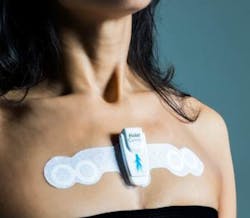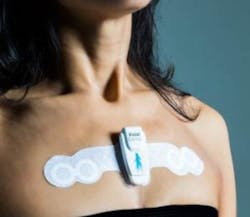Health patch lays foundation for better mobile health solutions
Leuven, Belgium, and Eindhoven, The Netherlands. At electronica, imec, Holst Centre, and TNO have introduced their next-generation health patch. The small form-factor comfortable-to-wear health patch has been optimized for low power consumption and is the first of its kind to track physical and cardiac activity, while monitoring bioelectrical impedance. A key building block in the pursuit of improved and more accurate mobile health solutions, the patch is available for licensing by partner companies ready to initiate their own medical applications.
“Since our entry in this space, we’ve advanced far beyond proof-of-concept to a patch that has attained a high level of technical maturity,” said Ruben de Francisco, program manager wearable health at imec and Holst Centre, “The underlying technologies have been fully validated, and the patch itself has been tested within a controlled environment. Today, it is ready for preclinical and usability studies. Looking ahead, we plan to build on our expertise in the domain of data science to lay the foundation for a powerful patient management solution that not only captures data, but that also turns data into meaningful information upon which people and health providers can act.”With more people living longer than ever before and chronic disease on the rise, traditional healthcare systems are being pushed to their limits. It is generally acknowledged that the concept of digital health, and specifically mobile health, can help address that issue by enabling individuals to better track and manage their health and receive personalized and optimized treatments while reducing medical inefficiencies and costs.1
The health industry has recognized the challenges and solutions, with analysts predicting that the value of the global mobile health market is expected to more than triple in the next few years, from $19.2 billion in 2016 to $58.8 billion by 2020.
However, for mobile health solutions to be successful beyond concept, easy-to-use and accurate building blocks are required; technology that is being developed by imec, Holst Centre, and TNO as part of their Wearable Health program. Their R&D on mobile health drives innovation from an application perspective, at system level and in terms of individual components—such as read-out circuits, batteries, and adhesives.
The health patch from imec, Holst Centre, and TNO features more functionalities than any other patch, and does so in a small form-factor, the organizations report. At its heart is a chip that has been optimized for low power consumption. This chip is combined with a highly comfortable to wear electrode patch that can stay on the body for long periods of time, including when showering. It is the first patch to combine a variety of sensing capabilities—ranging from an accelerometer (to track a person’s physical activity) to ECG tracking (measuring the heart’s electrical activity) and bioelectrical impedance monitoring (measuring body composition, respiratory activity and the distribution of body fluids).
“Many companies working in the digital health realm have great ideas for innovative solutions that could make it easier to remotely monitor people suffering from heart and respiratory diseases, to give an example. However, what is typically lacking, are the devices on which to run these solutions,” commented Chris Van Hoof, program director wearable health at imec and Holst Centre. “When collaborating with Holst Centre, we help these companies to take the next steps, from concept to device, and our health patch is one of the many vehicles available for licensing and customized product development,” adds Jeroen van de Brand, Director flexible electronics at Holst Centre/TNO.
The health patch integrates unique technologies and components from industrial partners, including Hitachi Maxell’s batteries optimized for wearables, Shinko Electric Industries’ System in Package (SiP) miniaturization technology, and Henkel’s adhesive and ink technology.
About the Author

Rick Nelson
Contributing Editor
Rick is currently Contributing Technical Editor. He was Executive Editor for EE in 2011-2018. Previously he served on several publications, including EDN and Vision Systems Design, and has received awards for signed editorials from the American Society of Business Publication Editors. He began as a design engineer at General Electric and Litton Industries and earned a BSEE degree from Penn State.

